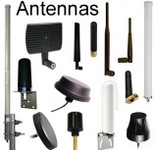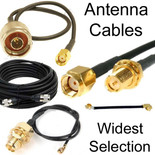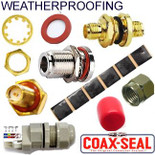5G Antennas and IoT Integration in 2023
The integration of 5G technology into the Internet of Things (IoT) landscape is ushering in a new era of connectivity and innovation. In this article, we will explore how 5G technology is influencing IoT connectivity and the specialized antennas that play a pivotal role in enabling 5G IoT applications. This powerful combination of 5G and IoT is reshaping industries, unlocking new possibilities, and driving technological advancements across various sectors.
The 5G-IoT Synergy
The synergy between 5G and IoT is undeniable. 5G's capabilities align perfectly with the requirements of IoT devices, creating a harmonious partnership that is transforming industries and enabling new use cases.
High-Speed Data Transfer
5G networks are renowned for their blazing-fast speeds, with the potential for gigabit-per-second download and upload speeds. This high-speed data transfer is a game-changer for IoT devices that require real-time data transmission. Consider the possibilities: autonomous vehicles that make split-second decisions based on sensor data, smart cities that optimize traffic flow in real-time, and remote healthcare monitoring that delivers critical patient data instantly. The speed of 5G is not just a convenience; it's a necessity for these applications.
Ultra-Low Latency
One of 5G's defining features is its ultra-low latency, ensuring minimal delay in data transmission. In applications like remote surgery, where precision is paramount, or autonomous vehicles navigating busy streets, this low latency is life-saving. It enables near-instantaneous communication between devices, preventing accidents and saving lives. Imagine a surgeon performing a delicate procedure remotely with no perceivable delay, thanks to 5G's low latency.
Specialized Antennas for 5G IoT
At the heart of the 5G-IoT revolution are specialized antennas designed to harness the power of 5G networks efficiently. These antennas come in various forms, each tailored to specific IoT scenarios, optimizing network capacity and reliability.

IoT Antennas - Data Alliance
Beamforming technology directs a focused signal beam toward a specific device, increasing signal strength and reliability. This is crucial for applications like smart factories, where machinery needs a stable and fast connection for real-time monitoring and control. In a smart factory, 5G's beamforming antennas enable seamless communication among machines, leading to increased efficiency and productivity.
MIMO (Multiple-Input, Multiple-Output) Antennas
MIMO antennas use multiple antennas at both the transmitter and receiver to improve data throughput and link reliability. They are ideal for crowded IoT environments, such as smart cities, where numerous devices need to connect simultaneously without interference. Imagine a bustling city with thousands of IoT devices, all connected seamlessly through 5G MIMO antennas, enabling applications like traffic management, environmental monitoring, and public safety.
Advancements in IoT Applications
5G's impact on IoT goes beyond just speed and low latency. It opens the door to innovative IoT applications across various industries.
Smart Cities
In smart cities, 5G enables the seamless connectivity of countless IoT devices, from traffic lights and environmental sensors to public transportation and emergency services. These devices can communicate in real-time, optimizing traffic flow, reducing energy consumption, and enhancing public safety. Imagine a city that adapts to traffic patterns, automatically adjusting traffic signals and rerouting buses to minimize congestion.
Precision Agriculture
Agriculture is embracing IoT and 5G to improve crop yields and reduce resource waste. IoT sensors monitor soil conditions, weather patterns, and crop health, transmitting data to farmers in real-time. With 5G, farmers can remotely control irrigation systems, adjust fertilizer levels, and receive alerts about potential issues. This precision agriculture ensures efficient resource usage and sustainable farming practices.
Industrial Automation
In the realm of industrial automation , 5G's speed and reliability are transforming manufacturing processes. IoT-connected robots and machines communicate seamlessly, adjusting production lines in real-time based on demand and quality control data. Imagine a factory where robots and humans work in harmony, optimizing production and reducing errors, thanks to the power of 5G.
Healthcare
Remote healthcare monitoring is becoming increasingly vital, especially in a world where telemedicine is gaining prominence. With 5G, healthcare providers can remotely monitor patients' vital signs, transmit medical images, and even perform remote surgeries with minimal latency. This ensures that patients receive timely and accurate care, regardless of their physical location.
Energy Efficiency
5G also plays a significant role in optimizing power consumption in IoT devices. For remote and energy-conscious applications like environmental monitoring and smart homes, 5G extends battery life and reduces the need for frequent recharging. IoT devices can operate efficiently for extended periods, enhancing their practicality and reducing maintenance costs.
Edge Computing
5G facilitates edge computing, a paradigm where data processing occurs closer to the data source. This reduces latency and supports real-time decision-making in IoT applications. For instance, in autonomous vehicles, edge computing powered by 5G allows the vehicle to process sensor data and make split-second decisions without relying solely on distant cloud servers.
Intelligent Automation
The combination of 5G and IoT can streamline intelligent automation across various sectors. Manufacturing facilities can use IoT sensors to monitor equipment health, and with 5G, they can automate maintenance processes, reducing downtime and costs. Similarly, in logistics, autonomous vehicles equipped with IoT sensors and 5G connectivity can optimize routes and deliveries, reducing fuel consumption and emissions.

Small Antennas, Big Impact
Despite its capabilities, 5G antennas are becoming smaller, making them suitable for a wide range of IoT devices. This miniaturization allows for the integration of 5G connectivity into devices that were once considered impractical for such technology. From wearable health monitors to smart home appliances, 5G's reach extends to everyday consumer devices, enhancing their functionality and connectivity.
The IoT Revolution Powered by 5G
The integration of 5G technology with IoT is not just a step forward; it's a leap into a future where connectivity knows no bounds. The speed, low latency, and specialized antennas of 5G enhance IoT functionality, leading to numerous advantages across various industries. This synergy between 5G and IoT is not just transformative; it's revolutionary. It's driving the next wave of technological innovation and economic growth.
Posted by George Hardesty on 22nd Nov 2023
























